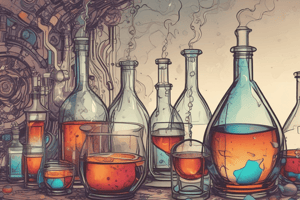Podcast
Questions and Answers
What type of alcohol is represented by the structure R-CH2-OH?
What type of alcohol is represented by the structure R-CH2-OH?
- Secondary alcohol
- Tertiary alcohol
- Vinylic alcohol
- Primary alcohol (correct)
Which of the following represents a secondary alcohol?
Which of the following represents a secondary alcohol?
- R-CH-CH3OH
- R-CHOH-CH3
- R-CH2-CH3OH
- R-CH(OH)-CH3 (correct)
Which process is commonly associated with the formation of carbocations during alcohol reactions?
Which process is commonly associated with the formation of carbocations during alcohol reactions?
- Hydrogenation
- Dehydration
- Hydrolysis
- Electrophilic addition (correct)
What is the main characteristic of vinylic alcohol?
What is the main characteristic of vinylic alcohol?
What is the product of the reaction of R-CH2-CH3OH with H+?
What is the product of the reaction of R-CH2-CH3OH with H+?
What type of alcohol is represented by the structure shown for CH2CH-cHy-oH?
What type of alcohol is represented by the structure shown for CH2CH-cHy-oH?
Which reagent is commonly associated with the merconium process in the synthesis of alcohols?
Which reagent is commonly associated with the merconium process in the synthesis of alcohols?
What is formed when a benzylic alcohol undergoes oxidation?
What is formed when a benzylic alcohol undergoes oxidation?
In the context of stability, which type of carbocation is more stable?
In the context of stability, which type of carbocation is more stable?
What is the primary source of the hydroxyl group in the reaction mentioned?
What is the primary source of the hydroxyl group in the reaction mentioned?
Flashcards are hidden until you start studying
Study Notes
Alcohols
- Alcohols are organic compounds containing the hydroxyl (OH) functional group.
- The general formula for an alcohol is R-OH, where R is an alkyl or substituted alkyl group.
- Alcohols are classified based on the number of carbon atoms directly attached to the carbon bearing the hydroxyl group.
- Primary (1°) alcohols have one carbon atom attached to the hydroxyl-bearing carbon.
- Secondary (2°) alcohols have two carbon atoms attached to the hydroxyl-bearing carbon.
- Tertiary (3°) alcohols have three carbon atoms attached to the hydroxyl-bearing carbon.
Preparation of Alcohols
- From Alkenes:
- Acid-catalyzed hydration:
- Reagent: Dilute H2SO4
- Mechanism: Electrophilic addition
- Follows Markovnikov's rule - hydrogen adds to the carbon with the most hydrogen atoms already attached.
- No rearrangements observed.
- Hydroboration-oxidation:
- Reagent: BH3 followed by H2O2/NaOH
- Mechanism: Syn addition
- Anti-Markovnikov addition - hydrogen adds to the carbon with the least hydrogen atoms already attached.
- No rearrangements observed.
- Oxymercuration-demercuration:
- Reagents: Hg(OAc)2/H2O followed by NaBH4
- Mechanism: Electrophilic addition
- Markovnikov addition - hydrogen adds to the carbon with the most hydrogen atoms already attached.
- No rearrangements observed.
- Acid-catalyzed hydration:
Sources of OH and H in Alcohol Synthesis
- The hydroxyl group (OH) can come from:
- Water (H2O)
- Sodium borohydride (NaBH4)
- The hydrogen atom can come from:
- Sodium borohydride (NaBH4)
- Water (H2O)
Vinylic and Allylic Alcohols
- Vinylic alcohols have the hydroxyl group directly attached to a carbon atom that is part of a double bond.
- Allylic alcohols have the hydroxyl group attached to a carbon atom adjacent to a carbon atom that is part of a double bond.
Benzylic Alcohols
- Benzylic alcohols have the hydroxyl group attached to a carbon atom that is directly attached to the benzene ring.
Ethylene Glycol and Glycerol
- Ethylene glycol is a dialcohol with two hydroxyl groups attached to adjacent carbons.
- Glycerol is a trialcohol with three hydroxyl groups attached to adjacent carbons.
Studying That Suits You
Use AI to generate personalized quizzes and flashcards to suit your learning preferences.




